
MAY CONTAIN NUTS

Search Shorpy
SHORPY ART

Framed or unframed, desk size to sofa size, printed by us in Arizona and Alabama since 2007. Explore now.
Join and Share
Ad-Free Shorpy
Shorpy is funded by you. Patreon contributors get an ad-free experience.
Learn more.

Recent comments
- Baldwin 62303
- Baldwin VO-1000
- Cold
- No expense spared
- Tough Guys
- Lost in Toyland
- And without gloves
- If I were a blindfolded time traveler
- Smoke Consumer Also Cooks
- Oh that stove!
- Possibly still there?
- What?!?
- $100 Reward
- Freeze Frame
- Texas Flyer wanted
- Just a Year Too Soon
- WWII -- Replacing men with women at the railroad crossing.
- Yes, Icing
- You kids drive me nuts!
- NOT An Easy Job
- I wonder
- Just add window boxes
- Icing Platform?
- Indiana Harbor Belt abides
- Freezing haze
- Corrections (for those who care)
- C&NW at Nelson
- Fallen Flags
- A dangerous job made worse
- Water Stop
Member Photos
The Shorpy
Print Emporium
Print Emporium
Search Shorpy
Search results -- 30 results per page
- New Jersey
- ... M&E's trek westward.
(ShorpyBlog, Member Gallery, Railroads) ... Posted by John.Debold - 09/18/2011 - 10:33pm -
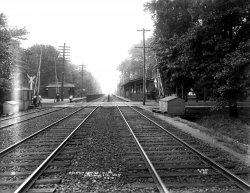
- Retarder Tower: 1942
- ... today.
(Technology, The Gallery, Chicago, Jack Delano, Railroads) ... Posted by Dave - 06/03/2013 - 9:31pm -
![Retarder Tower: 1942 November 1942. "Chicago, Illinois. South classification yard seen from retarder operators' tower at an Illinois Central Railroad yard." Medium format nitrate negative by Jack Delano for the Office of War Information. View full size.
Fantastic imageI admit I am a railroad "groupie", but this picture is incredible.
Jack Delano may be the Ansel Adams of railroad images.
The ultimateTrain Set.
Not a groupieBut a rail fan like me and many others who love trains, would this be Markham yard on the IC? (IC the train)
Something to considerAs we enjoy these photos, we should give a tip of the hat to the photographers who often risked life and limb to make them. In this Delano photo take a look at the tower off to the left. I've been in such towers, and whether Jack had to climb up a straight ladder or take an outside spiral stair, there are spots with no handhold and the top higher than it appears. Bulky photography equipment in those days would probably have hung from his body by rope as he climbed or pulled up hand over hand by rope - no easy task. Then they had to produce artistic photos and develop them carefully. Devoted people!
[In this case, Delano was shooting 120 roll film, most likely using a camera similar to the one he's shown with here. -tterrace]
The Proviso YardsActually located in west suburban Hillside, Illinois. These yards are 1/2 mile from where I grew up in the 50s and 60s.
I bet you're right, ferrochrr. All the big yards in the "rail hub of the country" begin to look alike!
Proviso?Proviso yard would be C&NW RR, (UP RR today) not the IC, as for climbing up into RR towers, they were not hard to do, sure the stairs could be a little steep, but certainly not difficult to manage. I've been in a few towers myself for photo opportunities as well.
Connection queryCan someone explain how the levers on the control panel were connected to the switches in the distance? Looks to me as if only a few inches of movement on the lever would activate a switch on the rails that must have been relatively large. How was it done? Cables? Motors? Is the same principle used in modern railroading?
LeversTo answer some questions, the levers in this photo were connected to the points by means of electrical connections. Previously they were mechanical, in that the levers pulled a number of point rods that activated the retarders and switch points. Sometime around 1930, IC upgraded their systems to a more modern type that used motors and electrical impulses to activate things. Believe it or not, though largely modernized, a similar system is still in use today.
(Technology, The Gallery, Chicago, Jack Delano, Railroads)](https://www.shorpy.com/files/images/SHORPY_8d23233a.thumbnail.jpg)
- The Dining Car: 1902
- ... and I often heard those as a kid.
(The Gallery, DPC, Railroads) ... Posted by Dave - 07/18/2012 - 7:03pm -
![The Dining Car: 1902 Circa 1902. "Delaware, Lackawanna & Western Railroad dining car." 8x10 inch dry plate glass negative, Detroit Publishing Company. View full size.
More on The SilverwareI believe that the waiter would set the appropriate utensils for each course from the attractive arrangement. There isn’t a lot of room at these tables and I have been to restaurants where the waiter set the silver before each course.
Strange Display?The Silver Ware display on the tables looks awfully strange...wonder why that was placed that way?
DL&WThis is what train buffs call "High Varnish." Mighty nice.
I'm pretty sure I haven't missed an opportunity, every time the DL&W is featured here, to mention that when my grandmother rode that line, over 100 years ago, they all said that the letters DL&W stood for Delay, Linger and Wait.
Style of Long Ago....Incredible elegance that was probably taken for granted back then. Superbly designed (notice the condiment racks on the bulkheads), hat racks, nighttime dining with electric lights overhead. And electric fans! What will they think of next. The use of mirrors that visually make the dining car larger than it appears. This dining car appears to have it all! The man in the aisle does have a bit of a ghostly appearance, though.
According to Lucius BeebeThe varnish diners were meant to give the traveler the same dining experience as the First Class hotel they left and the one they were traveling too.
Re: Strange Display?I didn't notice it at first, but you are correct in that the layout is quite unusual. Of course, I absolutely love it, and will try the layout the next time I have a formal dinner party. It almost looks as if it is supposed to represent the railroad crossing sign.
Thanks to a co-worker, the silverware layout has been identified as a "Dragonfly Pattern". - gen81465
Try Your SkillHit the fork handle, flip the knife and spoon into the vase. Win a free order of fries.
Railroad nicknamesRegarding Jazznocracy's comment, it reminded me of a small rail line many years ago that served the timber areas of East Texas. Its official name was the Waco, Beaumont, Trinity and Sabine Railway [WBT & S].
However, due to a constantly precarious financial situation throughout its short life, combined with improper track maintenance as a result, most folks said WBT & S stood for Wobbledy, Bobbledy, Turnover and Stop.
It would be interesting to find out how many other "unofficial" railroad nicknames were out there using the letters of the rail companies.
DL&WAlong with "Delay, Linger and Wait," another DL&W nickname was "Dread, Long and Weary." My dad was a lifelong DL&W/EL employee and I often heard those as a kid.
(The Gallery, DPC, Railroads)](https://www.shorpy.com/files/images/SHORPY_4a20189a.thumbnail.jpg)
- The Poughkeepsie Peeper: 1900
- ... I just recently watched on TCM.
(The Gallery, Kids, Railroads) ... Posted by Dave - 12/21/2015 - 10:39am -
![The Poughkeepsie Peeper: 1900 New York circa 1900. "Waiting for the train, Depot near Poughkeepsie." 5x7 inch glass negative rescued from an Upstate attic. View full size.
JeepersThat guy inside gives me the creepers.
It was the birthOf the photobomb.
Bring on the BoysWaiting for the Beefcake Collegiate Rowers in wool shorts to arrive?
Waitingfor Will Parker to arrive on the 9:10 and sing "Everything's Up to Date in Kansas City"
Distinctive ArchitectureI predict that some Shorpy Sleuth will have an identity for this station in a short time because of its distinctive architectural features:
* Brick construction. (Most RR stations are wood frame.)
* Curved, corbelled lintels on the windows.
* Wrought iron eve braces.
I know of only three RR's near Poughkeepsie on the east side of the Hudson: the New York Central, the Central New England , and the Newburgh, Dutchess, and Connecticut RR.
Of these, my first hunch is that it is _one of_ the Poughkeepsie stations which preceded the current ex-NY Central station. The substantial construction supports this. However, this would be "in", rather than "near" the City of Poughkeepsie.
My second hunch is that it will be the station of the Central New England Rwy. I surmise this could be their station on the Poughkeepsie Bridge Route, which would put it on high ground overlooking the City of Poughkeepsie, thus perfectly fitting the caption.
One interesting aspect is the height of the platform upon which they are sitting, and the bare ground in front of it. This looks for all the world like the BACK of a station, the side facing away from the tracks.
Now, the challenge is to come up with another old photo with a matching station, positively identified!
More like 1915Okay, none of these folks are particularly fashionable, but there are a number of clues indicating a date later than 1900.
1. The lady on the left with her tiered skirt and angular hat - both typical for around 1914/15.
2. The lady with no hat (a remarkably casual way to appear in public at the time) has a flat top loosely marcelled hair-do most popular in the mid nineteen-teens - her loose comfortable looking dress - same period.
[This is from a batch of glass negatives dated 1900 to 1902. - Dave]
A Spectacle The Gentleman standing at the far right has a haircut that caused me to look twice. For a moment I thought he was wearing his eyeglasses atop his head as many of us do to rest our eyes.
[He seems to be holding a conductor or stationmaster-type cap. - Dave]
I Love This Photo!A successful young family on their way down to NYC? Could that be the Nanny on the left? Or is the Lady traveling with the Fellow sitting inside the door?
Thank you Shorpy for this Amazing Channel to The Past!
From a Disney movieAfter the comments on the adults, I can't help but notice the kids seem to be dressed up in their best summer clothes for the trip. The oldest boy looks like Bobby Driscoll has escaped from the Disney movie "So Dear to My Heart" that I just recently watched on TCM.
(The Gallery, Kids, Railroads)](https://www.shorpy.com/files/images/SHORPY-836.thumbnail.jpg)
- Aerial Washington: 1911
- ... the hotel under construction.
(The Gallery, D.C., DPC, Railroads, Stores & Markets, Streetcars) ... Posted by Dave - 04/09/2014 - 1:24pm -
![Aerial Washington: 1911 Circa 1911. "Washington from Washington Monument." Points of interest in this first installment of a six-segment panoramic view include B Street (today's Constitution Avenue), running diagonally from the Potomac Electric powerhouse at lower left; Louisiana Avenue, branching off in the general direction of Union Station at upper right; the Old Post Office and its clock tower at left-center across Pennsylvania Avenue from the Raleigh Hotel under construction; the Agriculture Department greenhouses in the foreground with a corner of the Smithsonian "National Museum" at far right, just below Center Market; Liberty Market at upper left, below what looks to be a vast tent encampment; and, at right-upper-center, the Pension Office north of Judiciary Square and the District Court House. 8x10 glass negative, Detroit Publishing Co. View full size.
"Tents"All those tents are actually slate turret roofs on top of rowhouses. Very typically, a pyramid shaped slate turret would top off the projecting bay of a DC rowhouse. All four sides would have been slated. Slate, because of its mineral content (lots of mica) can be very reflective at certain angles, hence the white appearance.
[Conical was also popular. - Dave]
SurprisingSurprising lack of motorized vehicles for ca. 1911.
[Here are seven. - Dave]
Cargo TramNow there's something I had never really thought of: street cars for freight; a forerunner of today's semi-rigs I suppose. There's one being loaded/unloaded in front of the lumber yard.
First of six?Great! Bring them on!
Kann's Busy Corneraka Kann's Department Store. A good history of the life and death of the buildings can be found here.
[More here. - Dave]
+86Below is the same view taken in December of 1997. (Please excuse my still-limited scanning talents - this was before I switched to digital.)
DC in 1911What a great photo. More of these buildings than one would think are still there. The "District Court House" south (right) of the great Pension Building on Judiciary Square is the original DC City hall, started in 1820. After a several-years-long redo, it now houses in grand style the DC Court of Appeals (the state supreme court for the District.) Peeking around the office building to the left of the City Hall on 5th Street NW is the then-new US Court of Appeals building, which housed what is now the US Court of Appeals for the DC Circuit until 1952, when it moved to the new federal courthouse on Constitution Avenue (now the Prettyman Courthouse.) The old US Court of Appeals building now houses the US Court of Appeals for the Armed Forces, on which I am privileged to sit. It is an exquisite little building, quite well-preserved, with many of its original furnishings.
Ford's TheaterI had a thought that Ford's Theater was off in this general direction, so I took a look. Not being all that familiar with D.C. I'm wondering if that is the peak of the theater with porthole just above the scaffolding atop the hotel under construction.
(The Gallery, D.C., DPC, Railroads, Stores & Markets, Streetcars)](https://www.shorpy.com/files/images/SHORPY_4a10391a.thumbnail.jpg)
- Far Horizons: 1943
- ... from the scene.
(The Gallery, Jack Delano, Landscapes, Railroads) ... Posted by Dave - 10/04/2014 - 12:24pm -
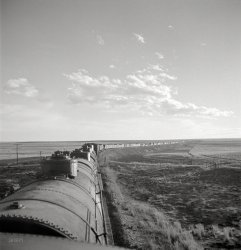
- Jackknife Bridge: 1907
- ... Shorpy.
(The Gallery, Boats & Bridges, Chicago, DPC, Railroads) ... Posted by Dave - 08/09/2012 - 11:56pm -
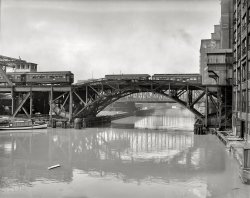
- Manhattan Municipal: 1913
- ... -tterrace]
(The Gallery, Boats & Bridges, NYC, Railroads) ... Posted by Dave - 05/03/2013 - 7:51am -
![Manhattan Municipal: 1913 Circa 1913. "New Municipal Building, New York City." The 40-story Manhattan Municipal Building and associated infrastructure including an elevated rail line and the Manhattan Bridge. 8x10 inch glass negative. View full size.
Still looking good!And a bit more complete, via Bing bird's eye view: http://binged.it/112au5S
Wedding Cake IIAt the top of the tower were the transmitters for the City-run TV and radio stations (now sold) as well as the base for the packet radio network. At least that what was there before I retired ten years ago. You can step out a window/door and walk around a narrow catwalk. Don't have acrophobia though!
No spindly little crane towerThey weren't taking any chances with that crane tower. Can't quite ferret out how that contraption was supposed to work, but unlike its offspring I doubt if it ever fell over.
Clean linesNotice the clean walkways in the park at the bottom of this picture; not even a fallen leaf to disrupt the casual passerby.
Lucky for meIt was a lucky day for me back in the early 90's when I was taken to the top of The Federal Building, opened the door to the roof and was greeted by this view. ( Also lucky that I happened to have a camera that day; though I only had four frames of film left to shoot. )
Wedding CakeWonder what offices/suites were located in the 'wedding cake' atop the building.
Deja vu all over againThis is a beautiful structure; I can see why it was chosen as the model for the Terminal Tower (formerly Cleveland Union Terminal) in downtown Cleveland.
I bought a marriage license here 85 years laterLittle did I know how much it would cost me over the long run!!
Wonderful photo - and so much still exists 100 years later! Out of all the buildings in the foreground, only the small building on the left between the building with the "To Let" sign and the squarish one with the mansard roof, and the plain brown one directly in front of the municipal bldg is gone - the rest are still standing proud. In the right foreground is the back of City Hall, and to the left is the Tweed Courthouse.
What is long gone of course is City Hall terminal of the IRT's Second Avenue El, where at one time you could transfer to Brooklyn-bound trolleys that trundled over the Brooklyn Bridge (out of view on the right).
In the plaza just in front of the Municipal building you can see a subway entrance kiosk to the IRT's City Hall station, which opened nine years before this photo was taken in 1904. The kiosk still exists, although it has been moved about 30 feet and now houses an elevator. The stairs leading down to the subway are now open to the elements - ah, progress!!
Windsor McKayThis building looks like Windsor McKay dreamed the top of this but someone like Sullivan saw the rest of it to completion.
[It's Winsor McCay. -tterrace]
(The Gallery, Boats & Bridges, NYC, Railroads)](https://www.shorpy.com/files/images/SHORPY_4a24481a.thumbnail.jpg)
- Full Steam Ahead: 1904
- ... still my grandfather's axe.
(The Gallery, Albany, DPC, Railroads) ... Posted by Dave - 05/16/2016 - 12:51pm -
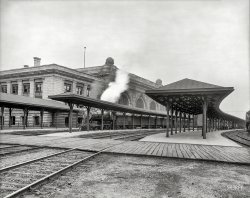
- Fresno Fruit & Honey: 1915
- ...
(The Gallery, Cars, Trucks, Buses, Railroads) ... Posted by Dave - 11/18/2015 - 11:52am -
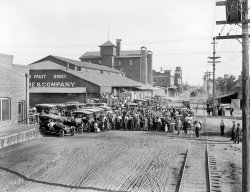
- Gold Coin Mine: 1900
- ... of "new construction" around!
(The Gallery, Mining, Railroads, W.H. Jackson) ... Posted by Dave - 07/20/2012 - 1:38pm -
![Gold Coin Mine: 1900 Circa 1900. "Victor, Colorado. Gold Coin Mine." 8x10 inch dry plate glass negative, Detroit Publishing Company. View full size.
Coontown 400Just to the right of the building with the painted advertisement for "Elector" cigars, you can see a fence plastered with advertising for "Coontown 400", a variety troupe.
Whether it is the same troupe as below or not, I'm not sure. Perhaps they had already made bookings and then went bust. I couldn't find another revue by the same name. Although there is a cartoon book called "Coontown's 400" by E.W. Kemble, published in 1899, "with what we would today consider racist portrayals of "darkies".
"Coontown Four Hundred (also Coontown 400). Variety troupe, active at the turn of the century, which underwent a number of changes of name and management. The orig. troupe, under white proprietorship, played Cincinnati, OH, in May 1899 with a roster that included the Blackstone Quartet, Tom Brown, Edna Alexander, Ida Forsyne, Whitney and Tutt, and others; it then disbanded in Nov. of the same year for non-payment of salaries. Management was taken over by Howard McCarver in September 1901, and the name was changed to A Honolulu Coon Co..." "The African American theatre directory, 1816-1960"
"One of Arthur Marshall's anecdotes has Marshall and [Scott] Hayden both living with the Joplins. This had to have been in late 1902 or 1903, for Marshall had been on a two-year tour with the Dan McCabe's Coontown 400 until the fall of 1902. It was probably at the end of the tour that he moved in with the Joplins, for Dan McCane in December was in St. Louis and visited the Joplins" "King of Ragtime: Scott Joplin and his era"
One Hundred and thirteen polesAmazing. Telephone, telegraph, electric, I counted one hundred and three poles before I started seeing double. Then spotted several more. You could spend days studying the histories of technology, architecture, construction, transportation, manufacturing, marketing and more, just in this single photograph. I love it. Still haven't found Waldo, however.
What a Project!Super photo from which to fashion a scratch built model railroading site in one's basement. So much going on, track at several different levels, limitless building designs, and a background that leads into a diorama-like mountain scenic.
I'd put a flag on that pole next to the smokestack, however.
Victor RR Depot - then and nowFrom the building with the Elector Cigars sign, follow that street to the right and where it ends you will find the Victor Midland RR Depot. The depot's overhanging roof casts dark shadows on the side of the building, which was the center of much activity at the time this photo was taken. The depot still stands today in relative isolation and four photos of it taken in 2006 can be viewed on this page. The eastern end of the depot is closest to the camera in the 1900 photo, which looks to the southwest.
August 1899 FireA large part of Victor burned to the ground in 1899, and it is said that most of the town was rebuilt in six months of brick instead of wood. It does seem as though there is a lot of "new construction" around!
(The Gallery, Mining, Railroads, W.H. Jackson)](https://www.shorpy.com/files/images/4a09194a.thumbnail.jpg)
- Message Received: 1943
- ... fast this train would have been moving? I know nothing of railroads, but quite a bit about photography, and I'll say that even with great ... in the original photo.
(The Gallery, Jack Delano, Railroads) ... Posted by Dave - 06/06/2015 - 1:10pm -
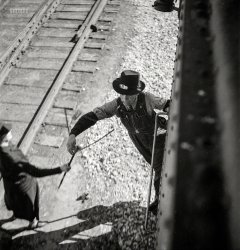
- Rolling Stock: 1941
- ... railroad spur.
(The Gallery, M.P. Wolcott, Railroads) ... Posted by Dave - 10/02/2019 - 12:59pm -
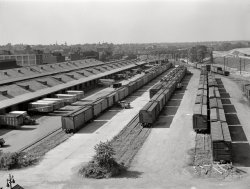
- Cane Train: 1897
- ... and cottonmouths.
(The Gallery, Agriculture, DPC, Railroads, W.H. Jackson) ... Posted by Dave - 12/13/2020 - 2:21pm -
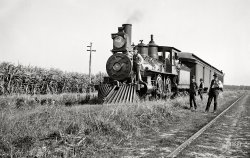
- Elmhurst Depot: 1899
- ... here, 120 years later:
(The Gallery, Chicago, DPC, Railroads) ... Posted by Dave - 04/26/2018 - 1:41pm -
![Elmhurst Depot: 1899 Elmhurst, Illinois, circa 1899. "Chicago & North Western Railway station." 8x10 inch dry plate glass negative, Detroit Photographic Company. View full size.
Wrong middle letterI'm thinking this is not the CNW station, which was a frame structure. Instead I believe it's the Chicago Great Western station (alternately the Chicago, Alton & Elgin), which was constructed of brick and was torn down sometime after 1960. (The CNW station survives, and is used by the Elgin parks department.)
[Incorrect. Searching eBay for "elmhurst postcard" would be a super-easy way to check. Click to enlarge. - Dave]
MemoriesThis picture reminds me so much of the St.Louis and San Francisco (StlSF) depot in my hometown of Columbus, Kansas. The milk cans were all on the freight platform ready to load when the train arrived plus any boxes or crates that needed shipped. In the spring, after the train had been, there might be crates of chicks cheeping that people had ordered from a supplier and other assorted boxes and crates that had been unloaded. With the steam, bell ringing, chuffing of the engine while it was in the station, and people debarking, It all seemed to be magic to me.
Elmhurst Depot: 2019Having been a resident of Elmhurst recently, I was moved to visit once more after seeing the 1899 photo above.. I tried to approximate the same position where the original photograph was shot here, 120 years later:
(The Gallery, Chicago, DPC, Railroads)](https://www.shorpy.com/files/images/SHORPY-4a04073a.thumbnail.jpg)
- Eggerss-O'Flyng: 1938
- ... 30 minutes.
(Panoramas, Factories, John Vachon, Omaha, Railroads) ... Posted by Dave - 08/08/2020 - 10:15am -
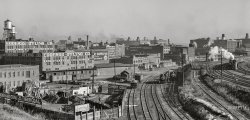
- The Hippodrome: 1905
- ... operating hotel in the city?
(The Gallery, DPC, NYC, Railroads) ... Posted by Dave - 08/14/2012 - 8:24pm -
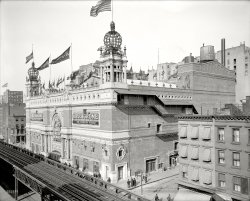
- A Chorus Line: 1905
- ...
(The Gallery, Boats & Bridges, Cleveland, DPC, Railroads) ... Posted by Dave - 07/30/2012 - 11:16pm -
![A Chorus Line: 1905 Lake Erie circa 1905. "Hulett clamshell hoists, Cleveland, Ohio." 8x10 inch dry plate glass negative, Detroit Publishing Company. View full size.
Nine men......one must look hard to find most of them.
Count the PeopleI stopped counting at eight people, upon encountering an additional one that I couldn't tell about.
Two guys with great proprioceptionAnd they give you a sense of the huge size of this processing plant. I wonder how many men got injured falling off the hoists, working up there in various drenching conditions?
How exactly did these hoists work? They would lift up nets or pallets full of oysters, which would then be trundled out by conveyor belt? The din and smell of a fleet of ten boats unloading at one time must have been stupefying. Do you have any shots of this plant at work?
[Clamshell hoists don't have anything to do with oysters, clams, or seafood in general. They're for loading iron ore. - Dave]
I count 11if you include "the Shadow".
ClamshellsTechnically, clamshell hoists are so named because they (somewhat) resemble and open and close similarly to the bivalves' shells.
Brown Fast PlantsTracking down the historical/technical details of this photo was complicated because the internetz are full of information on its more famous kin: the still-standing Hulett Ore Unloaders.
Nonetheless, the best information on the pictured machinery is in the 1905 book, "Brownhoist": Patent Automatic Hoisting and Conveying Appliances. Pages 43 & 44 have alternate views of the same equipment.
Briefly: The location is the Cleveland & Pittsburgh Dock of the Pennsylvania railroad. This type of hoist, designed by Alexander Brown, was known as a "fast plant" and was used to unload ore from a ship and transfer it to waiting rail cars. The specimens here were all steam-powered but later models used electricity. The unloading arm of the hoists spanned 5 to 7 railroad tracks and could load fifty rail cars without shifting. The business end of the hoists were equipped with Hulett clamshells and Andrews scrapers.
Hulett ClamshellsThese are Brown rigs with Hulett clamshells, as noted in the caption, for transferring ore onto railcars from ships called ore carriers.
I count 11 alsoI also count 11 including the man bent over behind the crane rails near the steam vent and the 3 atop the rail cars
What's up dock?Since 1858, gravity has been used to load ore boats (naval tradition notwithstanding, all bulk carriers are "boats" on the Great Lakes) from structures properly known as "ore docks."
The system was introduced at Marquette, Michigan. Ore was delivered to the top of the dock, and dumped into large holding pockets, each fitted with a side discharge chute. Brigantine-rigged (no boom between masts) Schooners were the favorite for ore shipments. They came alongside and typically loaded ore directly on deck, roughly 300 tons per trip — which could take four or more days to offload by hand on arrival, longer if it was loaded in the holds below deck
As demand for ore skyrocketed, deck hatches were cut into these vessels to increase capacity. The first bulk freighter (the R.J. Hackett) was purpose-built for the iron ore trade in 1869. These bigger vessels opened the floodgates to a variety of mechanical unloaders mentioned in the earlier post, but the Brown and Hulett machines emerged as the leaders.
A Brown bucket held roughly 1-1/2 tons, but the machine could only lower and raise the bucket straight into the hold, where it still had to be filled by hand; fitting the machine shown with clamshells should have greatly improved its efficiency.
The first Hulett bucket held 10 tons (later models could handle up to 22 tons per bite), but its greatest advantage was its mobility, as it could move up & down, left & right and forward/reverse within the hold, greatly reducing the hand shoveling.
Lakes boats didn't come home to Michigan empty, they typically backhauled coal, which was also loaded by gravity.
(The Gallery, Boats & Bridges, Cleveland, DPC, Railroads)](https://www.shorpy.com/files/images/4a11185a.thumbnail.jpg)
- Live Third Rail: 1910
- ... in between.
(The Gallery, Detroit Photos, DPC, Railroads) ... Posted by Dave - 07/22/2014 - 11:55am -
![Live Third Rail: 1910 Detroit circa 1910. "Michigan Central R.R. tunnel." Another in a series of views of the approach to the train tunnel under the Detroit River. Please note: LIVE THIRD RAIL, DO NOT TOUCH. 8x10 inch dry plate glass negative. View full size.
Snake EyesI'm thinking of some fellow holding up a convenience store; the clerk pulls out a double barreled shotgun, and this is what the robber sees.
Do not touch?That sign is an understatement. I believe those rails carried 750 volts DC.
Under-Running Third RailThis is the "Under-Running" type of third rail, where the pickup shoes on the locomotive run on the bottom of the rail. The rail is sort of hanging from C-shaped insulated supports. The insulators are under tension.
This is superior to the common "Over-Running" third rail because the top and both sides of the electrified rail can be protected against accidental contact. In this photo, one can see that the top and both sides of the rail are covered in wooden sheathing. (In the more common Over-Running 3rd rail, only the back side and the top of the rail can be guarded; the track side must remain exposed.)
This is the type of 3rd rail used in other New York Central System electrification projects under the control of VP of Engineering William J. Wilgus. This type of 3rd rail is used in Grand Central Terminal and on all line approaching it. (The former New Haven transitions to overhead wire, but operated within NY City limits on the 3rd rail.)
All of this sort of third rail in the NYC /Westchester area has been changed from wooden sheathing to fiberglass sheathing, which is safer because it cannot absorb water.
Now, if Shorpy could only find a photo of the electric locomotives which traversed this tunnel.
[Electro-Motive. -tterrace]
Street LampI want this street lamp in my driveway! I have scoured the internet in search of appealing exterior lighting, and haven't found anything nearly as interesting as this one. I don't know what it is about it, it's just perfect.
[It's a carbon-arc fixture on a "bishop's crook" standard. - Dave]
Tunnel locomotivesIt would be nice to have a large format photo of one of the period engines on Shorpy. Most of the ones I've found are kinda fuzzy and don't do justice to the picture of the tunnel.
[Click to enlarge. - Dave]
Lobster, lettuceand everything in between.
(The Gallery, Detroit Photos, DPC, Railroads)](https://www.shorpy.com/files/images/4a23707a-SHORPY.thumbnail.jpg)
- The Milwaukee Road: 1943
- ... anyone enlighten?
(The Gallery, Chicago, Jack Delano, Railroads) ... Posted by Dave - 08/19/2013 - 2:15pm -
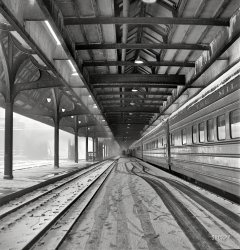
- Along the Ohio: 1940
- ... Industry & Public Works, Louisville, M.P. Wolcott, Railroads) ... Posted by Dave - 05/29/2019 - 10:28am -
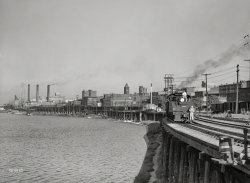
- Early Amazon: 1900
- ... miles away in St. Paul.
(The Gallery, Buffalo NY, DPC, Railroads) ... Posted by Dave - 03/06/2018 - 3:04pm -
![Early Amazon: 1900 Circa 1900. "New York Central freight sheds, Buffalo, N.Y." 8x10 inch dry plate glass negative, Detroit Photographic Company. View full size.
Safety FirstA sand-filled bucket 10 feet off the floor on every column for fire control.
Lots of manpower neededCan't imagine how many man-hours went into stacking just the sacks on the left, not to mention the thousands of barrels!! I believe I see a couple of them whose efforts helped make this scene so compelling over a century later.
Thoroughly modernIf you take away the barrels, the sacks, the hanging lamps, and the buckets of sand, this warehouse looks uncannily modern. Something about the crisp, even brightness and the light, metal structure.
Flour Is BloomingGold Medal Flour was my mother-in-law's favorite brand. My wife still uses it today.
Gold Medal flourStill a brand today, but, pretty sure, this isn't how it's stacked these days!
Vermin alertWith that many sacks of flour stacked that deep, I hope they have a couple of hungry cats hanging around.
Just the sacksGold Medal - flour, still today.
I wonder what's in the barrels.
State of the art architecture.I'm no historian of architectural engineering, but the construction of this warehouse must have been state of the art for 1900.
Life before forkliftsIt's weird to see a warehouse look so light, airy, and neat. Today, forklifts allow warehouse-men to lift items to dizzying heights, making sure that the only light available is artificial. And with rare exceptions, nobody would dare put a wood floor in a warehouse--you'd wear right through it, and quickly, with the tires of your forklifts.
That noted, the frame of the building looks about the same as today. The big difference is you'll get a lot more lights hung from it, and instead of rivets, they're often welded.
"Slack Barrels"Made with thin fir staves tongue and groove jointed, and with sapling hoops, these were called slack barrels, and they wouldn't hold a liquid for five minutes. They are indeed flour barrels. A crepe-like paper liner inside each barrel prevented sifting the flour out between the stave joints.
Washburn Crosby Co of Minneapolis produced their Gold Medal Flour in Minneapolis, and eventually became General Mills - still producing Gold Medal Flour a century and a half later.
round bottomit looks to me as at least the fire buckets i can see in the image that none have rounded bottoms all fire buckets i have ever seen had rounded bottoms that i believe the purpose being that it forced one to hang it up and thus readily available for use and not have to search for one. another words hang it up or it tips over and loses its contents and it hung up if itd empty it is deemed useless for fire. anyone have different on what i just said and how it might tie into these buckets being flat i believe.
[leading candidate for this years ee cummings commenting fellowship way to go man - dave]
Gas light districtAre those gas lamps hanging from a pipe?
Ka-boom?!?!?!When I was working in a supermarket in the late 1960s, we kids who worked there would amuse ourselves by taking bags of flour, tearing a big hole in them, lobbing them into the incinerator, and then quickly slamming the steel incinerator door shut.
The resulting explosions were powerful enough to bend the half-inch-thick steel door of the incinerator.
So I shudder to think of a flour warehouse with open-flame lighting. That stuff is dangerous.
EDIT: Here's our good friend, Mr. Wizard, explaining how flour dust can be explosive:
https://www.youtube.com/watch?v=8t5iTunRkO4
Yup! Same WashburnThe largest explosion in Minneapolis' history was the 1878 explosion of the Washburn "A" Mill in downtown Minneapolis. 'Twas heard 10 miles away in St. Paul.
(The Gallery, Buffalo NY, DPC, Railroads)](https://www.shorpy.com/files/images/SHORPY-4a08419a.thumbnail.jpg)
- Almost Heaven: 1938
- ...
(The Gallery, Boats & Bridges, M.P. Wolcott, Mining, Railroads) ... Posted by Dave - 04/08/2019 - 11:47am -
![Almost Heaven: 1938 September 1938. "Section of coal mining town near Welch, West Virginia." Possibly the mountain hamlet of Eckman. Medium format negative by Marion Post Wolcott for the Farm Security Administration. View full size.
BZZTThe Virginian Railway electrified about 130 miles of their railroad in the 1920s using 11,000 volts AC. Presumably the power was off during the operation captured in the photograph.
Why OSHA existsThe guy working on the power lines is putting himself in peril by 1.) possibility of electrocution from the electric lines themselves, and 2.) the possibility of a train coming through and taking out both him and his crew. Meanwhile, up the side of the hill, we see several very nice homes, and, knowing what I know about how plumbing works, and how **it flows, I'd probably rather own one of the homes higher up on the hill, thank you.
[If only we had been there to guide them! The worker's ladder is next to the tracks, not over them. - Dave]
Stairway to Heaven?Are those steps in the left hand of the photo leading up the hill? Covered drainage? If they are stairs they might be more precarious than that ladder the lineman is using! In the words of an old Bugs Bunny cartoon, "Watch that last step, it's a lulu!"
In the days before cherry-pickersYou had to use huge ladders to get up on the poles if you didn't have those pegs that were mounted on some poles.
HemphillLooks like the bridge is the one over the Tug Fork at 37.44116N 81.5931W. The railroad is the Norfolk & Western, and the bridge is 893-B, as the white-lettered marker probably says, just left of the catenary pole left of the bridge.
The track behind the workmen must lead to the coal hoppers in the other pic:
https://www.shorpy.com/node/24494
MoonshineSo, Dave, where is it?
Tall shortI know Shorpy. Is the guy on the ladder his brother Shorty?
In-house wire workThis is certainly a railroad crew working on the catenary. Note the short "train" in the left background. The enclosed car is what powered them here from their starting point, typically with a one-lung gasoline engine and perhaps built by Fairmount; the several four wheeled trailers carry their tools. This sort of RR maintenance crew transport is about nonexistent today, being replaced by high rail-equipped highway vehicles.
These guys are not here on their own; the dispatcher knows of their presence, and likely has given them train orders advising them of the limits they can work, and when they have to be clear of his railroad, or check back with him for further orders.
Tug ForkBased on Timz' ID of the trestle, it is over the Tug Fork, which flows northwest into Hatfield and McCoy territory. Based on the shadows, the shot was likely taken from the north bank looking southwards in the early morning. I guess the Google crew couldn't make it up the road.
RR Safety ProcedureThis being 1938 and not 1838, railroad safety procedures dictated that whoever was in charge of whatever work was being done had undoubtedly coordinated with the dispatcher, who issued "time & track" orders to all concerned, including train crews.
ImpressiveFirst the large white building with the top balcony leaning a bit; and then the male undershorts flying in the wind.
Lionel landscapeThe clean, simple bridge and the foreshortened look produced by the close and nearly vertical background make this scene look like a very well done model train layout!
Space XIf you travel a short distance to the north west along these tracks using the magic of Google Earth, you will find this secret missile launch pad disguised as an old steam locomotive coaling tower.
HemphillThe picture is Hemphill, WV.
(The Gallery, Boats & Bridges, M.P. Wolcott, Mining, Railroads)](https://www.shorpy.com/files/images/SHORPY-8c09394a.thumbnail.jpg)
- Machine Car: 1905
- ... locked state.
(The Gallery, Cars, Trucks, Buses, DPC, Railroads) ... Posted by Dave - 08/21/2012 - 6:29pm -
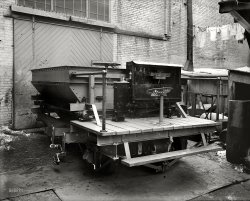
- Frosted Tracks: 1943
- ... assignment must have been!
(The Gallery, Jack Delano, Railroads) ... Posted by Dave - 12/08/2013 - 1:04pm -
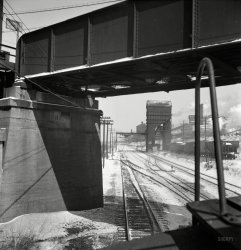
- A More Perfect Union: 1908
- ... today, which is magnificent.
(The Gallery, D.C., DPC, Railroads, Streetcars) ... Posted by Dave - 07/27/2016 - 12:30pm -
![A More Perfect Union: 1908 Circa 1908. "New Pennsylvania [Union] Station, Washington, D.C." 8x10 inch dry plate glass negative, Detroit Publishing Company. View full size.
So many travel choicesGreat photo showing three modes of transportation (besides the train, of course). The old horse drawn cabs on the left of the photo, the new automobile cabs on the far right, and the electric trolley. What a wonderful era for travel.
Lots of timeWe seem to be looking almost due North, across Columbus Circle. Judging from the shadows, it's early morning, probably late Spring or early Summer.
Long layover 'till quarter to four!
Union StationThis photo of D.H. Burnham's magnificent building was probably taken from the north end of the roof of the then-new Senate Office Building (later the Old Senate Office Building, now the Russell Senate Office Building), designed by Carrere and Hastings of New York and built in 1903 to 1908. I spent 10 years in there, working for the Armed Services Committee, on the south (Constitution Avenue) side of the building. The Committee's restored hearing rooms are wonderful examples of American Beaux-Arts at its most lavish.
I Was ThereNot in 1908, but two years ago, and it is still one of the most beautiful buildings I have ever had the privilege to wander in.
Even the façade looks similar to then.
Saved From RuinLooking at it now, it's hard to believe such a grand building came close ruin. The station was converted into a visitors center in the mid-seventies, which caused a lot of damage to many of the finer architectural features of the interior. When that failed the building was abandoned. By the early eighties it was a rat-infested mess with significant damage. The federal government could have easily walked away and let it fall into a state beyond repair. Fortunately, Congress authorized the purchase of the building and ponied up the cash to turn it into what it is today, which is magnificent.
(The Gallery, D.C., DPC, Railroads, Streetcars)](https://www.shorpy.com/files/images/SHORPY-4a23930a.thumbnail.jpg)
- Backwater: 1937
- ... refill in this event?
(The Gallery, Arthur Rothstein, Railroads) ... Posted by Dave - 04/25/2020 - 5:43pm -
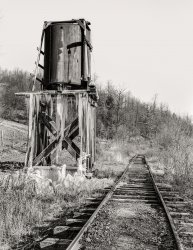
- Whistle Stop: 1936
- ...
(The Gallery, Arthur Rothstein, Dust Bowl, Politics, Railroads) ... Posted by Dave - 07/30/2012 - 10:03pm -
![Whistle Stop: 1936 August 1936. "Tour of drought area. President Roosevelt speaking from train at Bismarck, North Dakota." Medium format nitrate negative by Arthur Rothstein for the Resettlement Administration. View full size.
Family supportAlthough James was reported to be the one with his father, this certainly looks more like Franklin, Jr., who had just celebrated his 22nd birthday 10 days before. Not visible in the photo but also on the rear platform of the train was FDR's daughter, Anna. At right is ND Governor Walter Welford. Film footage of the event is here.
Lean on meFDR is gripping the arm of what I believe to be his son James. Roosevelt was completely paralyzed below the waist and had to use other people to help create the illusion of his being able to stand and walk. Great care was made to foster this illusion and the press generally went along with it. To this day there are no more than a handful of photographs of FDR in a wheelchair or that show his leg braces.
This is one reason so many photos of him were taken on the back of trains, where he could grip the railing, or in open cars where he didn't need to be seen moving under his own power. In fact whenever he was expected to deliver an outdoor speech other than from a rail car the Secret Service would build wooden ramps on the speaking platform so his car could drive right up onto the stage behind all of the dignitaries. who served to mask FDR from the crowds and cameras. Then they would pick him up from his car and stand him up with his leg braces and more or less carry him, one man on each side, to the speaking podium. Roosevelt would swing his arms and it appeared to all but those right next to him that he was walking.
"1936, You call this a drought?wait for the next two years."
Indiscreet then but history nowA long gone friend of my Father, Dr.Howard Rosenthall, somehow managed to film FDR in his actual physical state being helped from his limo during a visit to Vassar College. At the time this was NOT the correct thing to do; but, I am told, his film ended up at the Roosevelt Library were it is kept as a historical item.
Google HimIt's plainly Franklin Jr. and not James.
[Indeed. Three examples. - tterrace]
(The Gallery, Arthur Rothstein, Dust Bowl, Politics, Railroads)](https://www.shorpy.com/files/images/SHORPY_8b28235a.thumbnail.jpg)
- Superior Scales: 1941
- ... View full size.
(The Gallery, John Vachon, Mining, Railroads) ... Posted by Dave - 03/11/2020 - 3:12pm -
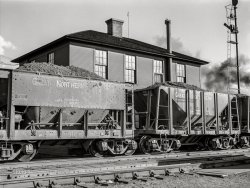
- Wheel of Fire: 1943
- ...
WDV
(The Gallery, Kodachromes, Jack Delano, Railroads) ... Posted by Dave - 08/30/2012 - 11:59am -
![Wheel of Fire: 1943 Re-tiring a locomotive driver wheel in the Atchison, Topeka, & Santa Fe railway shops at Shopton, near Fort Madison, Iowa. March 1943. View full size. 4x5 Kodachrome transparency by Jack Delano.
Fire WheelGreat picture would like to see more RR shop pictures
Delano PictsDid Jack work for the Santa Fe RR, or was he an avid railfan like many of us are especially me? I know you told me that he passed away 10 yrs ago, has his family saved and ever thought of giving his great pictures to Trains & Railfan mags? How were you able to get the photos? I'd like to know more about jack and who he was and how he lived.
[Have you tried the Internets? Google. Wikipedia. - Dave]
Fire WheelThis is an interesting shot but I believe the picture should be rotated 90 degrees clockwise. The heavy steel support illuminated below the flames is a stand that supports the axle and keeps the wheel off the ground. Notice the flames also point to the left (up). Nevertheless, this is a beautiful example of a common maintenance procedure on a steam locomotive. The steel tire is separate from the cast steel wheel center. The inside of the tire is machined several thousandths of an inch smaller than the wheel center. It's heated by fire from a ring of gas pipe. As the tire gets hot, it expands and is then driven onto the cooler wheel center by workmen with sledge hammers. It's then clamped into position and allowed to cool and shrinks tightly on the wheel. Jack Delano's photography captures the essence of railroading of this era with elegance and sensitivity.
[The wheel has been rotated. Below, a clearer view of the procedure. - Dave]
This process was also knownas "sweating" on a tire.
These series of photos are fantastic!
Ring of Fire explained:Comments from a friend -
Many's the night I supervised that same operation at Enola Enginehouse machine shop when we sweated new tires onto the P5 wheels. (GG1s had smaller wheels with tires but those were all done at Wilmington.)
The trick was, after the wheel cooled down to room temp. (after removing the tire) you had to measure WITH A MICROMETER, the outside diameter of the wheel to .001 inch. Then you had to measure the inside diameter of the tire also to .001 inch. As if that wasn't difficult enough, if it was cold outside and somebody opened the barn door the tire or wheel could change diameter and blow the entire exercise.
If the tire was too large, we had to choose the correct thickness of shim and insert it between the tire and the wheel while heating the tire with a flame.
Today that is all a lost art. Occasionally we'd get the tire too tight on the wheel and it would snap. Also tires would come loose during service. If the inspector suspected a tire was loose, he'd put a chalk mark across the tire and wheel and watch it when it came back onto the pit and see if the chalk line still matched up.
The P5s and GG1s didn't have dynamic brakes so the enginemen rode the independent brake a lot on the downgrades.
WDV
(The Gallery, Kodachromes, Jack Delano, Railroads)](https://www.shorpy.com/files/images/1a34708u.thumbnail.jpg)























